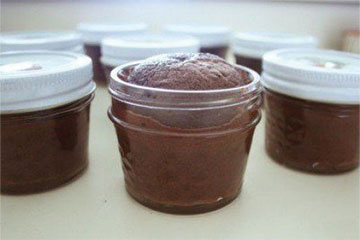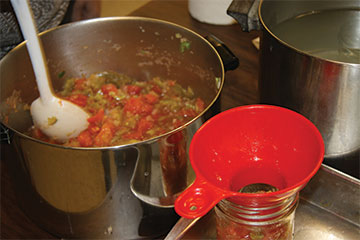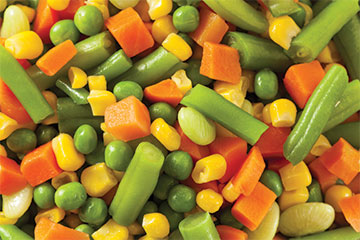
Is it safe to can breads and cakes? (Answer: NO!)

Information on baking and “canning” breads and cakes in jars has been circulating for at least 25 years and, more recently, has been shared on social media. One recipe you might see says to bake cakes or breads in canning jars; once they are done and steaming hot, it says to place a canning lid and screw band on top and (ta-da!) you have a vacuum-sealed jar of baked goods to give your family and friends. Some recipes claim they will keep for a year. But, hold on! Don’t be so fast to assume this practice is really all it is “baked” up to be.
The biggest concern with these types of recipes is the risk of Clostridium botulinum. If the C. botulinum spores are allowed to germinate and grow, a deadly botulinum toxin is produced. Even tiny amounts of this toxin can cause an often- deadly disease called botulism. The finished product is a low-acid, moist product in a jar with little to no oxygen and when stored at room temperature, creates a perfect environment for the spores to germinate and grow. Several research studies from universities have shown that bread or cake products in home canning jars may support the growth of C. botulinum spores.
National Center for Home Food Preservation strongly recommends not to bake and can cakes and breads in canning jars. The risk of botulism is real and can be fatal. Consumers should not take unnecessary risks with this microorganism. If someone gives you a homemade version of bread or cake in a canning jar, assume it is unsafe to consume and discard the contents and the jar.
There is also the risk of personal injury and damage to ovens due to potential glass breakage during the baking process. Canning jars are intended for use in a boiling water, atmospheric steam and/or pressure canners. Canning jars are not designed for the high, dry heat of ovens and jar manufacturers do not recommend this heat treatment.
Some people ask about commercially produced breads and cakes in jars or cans. Commercial processing uses additives, preservatives and processing controls that cannot be replicated in home recipes. Only purchase breads and jars in cans that contain additives to prevent microbial growth and meet all labeling requirements for commercial food. There are no research-based recipes for doing this process at home.
Source:
Ann Hamilton, Food Safety Field Specialist, University of New Hampshire Extension, https://extension.unh.edu/blog/2021/11/cakes-breads-baked-canning-jars-not-safe.
Are Two-Piece Lids Really Necessary? (Answer: YES!)

Home food preservation research continues to recommend and support the two-piece lid system, even though one-piece, screw-on lids are available….does it really make that much difference? It does! Commercial food canners fill containers to the top, then a device removes the air from the jar before the lid is quickly attached. Home canners don’t have those vacuum-sealing machines. What we do have is the two-piece lid, which works well if users follow research-based guidelines. This self-sealing system consists of a flat metal lid held in place by a metal screw band during processing. A trough around the edge of the lid holds a rubber-like, colored gasket. While the jars are being processed, the lid gasket softens and flows slightly to cover the jar-sealing surface, yet allows air to escape from the jar. The gasket then forms an airtight seal as the jar cools.
To ensure safe home canned foods, follow these important steps:
- Buy only the quantity of lids you will use in a year.
- Carefully follow the manufacturer’s directions for preparing lids to make sure you get a good seal.
- Check all metal lids carefully. Don’t use old, dented or deformed lids or lids with gaps or other defects in the sealing gasket.
- Do not re-use lids from previously canned foods
In home canning, one-piece lids allow air to be trapped within the sealed jar. This can permit bacteria to thrive and spoilage to occur, and that spoilage can make you ill and even lead to death. So why take the chance? Safely use a two-piece lid!
Source:
University of Missouri Extension, GH1452
Mixed Vegetables

Ingredients
- 6 cups sliced carrots
- 6 cups cut, whole kernel sweet corn
- 6 cups cut green beans
- 6 cups shelled lima beans
- 4 cups whole or crushed tomatoes
- 4 cups diced zucchini
Directions
- Except for zucchini, wash and prepare vegetables as described for carrots, corn, lima beans, snap beans or Italian beans and tomatoes. Wash, trim, and slice or cube zucchini; combine all vegetables in a large pot or kettle, and add enough water to cover pieces. Add 1 teaspoon salt per quart to the jar, if desired. Boil 5 minutes and fill jars with hot pieces and liquid, leaving 1-inch headspace.
- Pressure can for 75 minutes for pints and 90 minutes for quarts at 11 pounds pressure when using a dial gauge canner (this applies to elevation between 0 and 2000 feet). Pressure can for 75 minutes for pints and 90 minutes for quarts at 10 pounds pressure when using a weighted gauge canner (for 0 to 1,000 feet elevation) and 15 pounds pressure for elevations for over 1,000 feet.
Optional mix
- You may change the suggested proportions or substitute other favorite vegetables except leafy greens, dried beans, cream-style corn, winter squash, sweet potatoes, broccoli, cauliflower or cabbage.